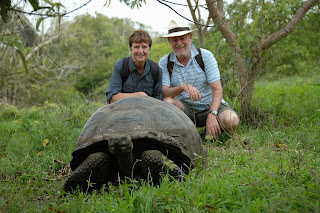The bird life on the islands
is fascinating with many species having developed unusual traits. One of the
most common is the Swallow Tailed Gull. It has a small red ring around its eye
and is the only nocturnal gull in the world. They are quite graceful ..
And for some reason quite
common…
Nests are often under small
bushes to make attack by predators difficult.
The range of birds is diverse
especially when many have evolved into sub-species based on each island. The Galapagos
mocking bird however is seen on a number of the islands.
On Santa Cruz during our first trip ashore we were treated
to these two Greater Flamingos.
Sharing the lagoon were a
number of birds including this reflective Solitary Sandpiper.
And on the shoreline an
American Oystercatcher
Now to move to more unusual
birds and first up is the Booby of which there are three species. The most
common and largest is the Nasca Booby with its distinctive black and white
plumage. Here is one incubating two eggs however only one will be reared as
the older (and stronger) normally kills the younger one. Selection of the
strongest again.
The second Booby is a bot
more colourful. The feet of the red footed Booby are a wonderful contrast to
its Cambridge blue beak.
And thirdly there is the blue
footed Booby. Their antics when courting a mate are clownish but mesmerising
with high foot lifting and as below sky pointing which is done in conjunction with
a whooshing sound.
All are graceful flyers and
great fishers where they dive from quite a height into the sea. In order to
share the food the Nasca Booby tends to fish further off shore than the other
two.
The most colourful vote has
to go to the Yellow Warbler. This female (without the redhead – a male is in
the earlier blog) started off a couple of metres away and just kept hopping
closer and closer until it was barely 300 mm away. It was as if she was as keen
as me for a good photograph.
There are also a number of
Herons on the islands including this Yellow-crowned Night Heron. Although they
look placid this one eventually decided to take on a pair of swallow tailed gulls
who had a fledgling. Fortunately the attempt was unsuccessful.
This Short-eared Owl was only
a foot or so off the ground and a metre off the path which is the closest I
have ever been to an owl.
Just as lacking in fear is the Galapagos Dove. (In fact Darwin
observed that he could capture one for the pot by throwing his hat over it.)
Even more numerous were Finches. Darwin in 1835 collected many samples (over
only a 5 week period to 4 islands) and when examining them back home realised there were many differences. 13
sub species have now been identified. He formulated the theory of what is now
known as adaptive radiation where one species evolves largely due to what food
is available (eg small ground finch through to large tree finches).
At the other end of the size
scale is the Brown Pelican. We also saw them diving for fish but that was a
little difficult to photograph.
Getting larger still with a
wingspan of some 2.3 metres is the Waved Albatross on Punta Suarez, Espanola
island. Courtship rituals are amazing. Although they have a mate for life it does
not stop some 20% of them mating with others – although they try to look quite innocent - who
me??
They also sky point (with a
moo sound) and bend their heads from side to side but the first stage of
their relationship (and repeated constantly) is banging together of their
beaks. The rat-a-tat happens so fast that getting a still photograph was impossible.
Helen managed to video some
of their antics on her iphone:
They find taking off a
challenge and walk to the cliff edge to benefit from the uplift, but once
airborne they are very graceful thanks to their 2.3 metre span.
Mind you these two reckon they have a bigger span (well jointly)
However, the most beautiful
prize has to go to the Red Billed Tropicbird. It’s extraordinarily long tail
feathers were just amazing.
Now to the famous Frigatebird that I am sure most will have seen pictures of somewhere. There are two varieties (Magnificent and
Great) however, even the guides found picking the difference challenging. They
have two unusual traits. The first is the male’s courting ritual which involves
blowing up his red pouch which the female can see from afar. It takes four hours
to inflate and the bigger and brighter it is the stronger the male.
This female has a chick that
is looked after for up to 6 months.
They are gifted flyers and
easy to spot with their forked tails.
But their main claim to
fame is that they are pirates. Although they can fish they prefer others to do
this for them and then attack to make the fisher disgorge its catch. I managed
to capture such an attack on a Swallow Tailed Gull. The latter just could not out
manoeuvre the larger bird.
Quite quickly the Frigatebird
gets hold of the tail or beak.
Which is sufficiently scary
for the gull to disgorge its catch (see the bottom of the photo) which the
Frigatebird then caught before the food hit the water.
Even if a bird is sitting on
the water it can be attacked.
How to wrap up Galapagos –
simply stunning and a must for anyone who enjoys wildlife and photography.























































